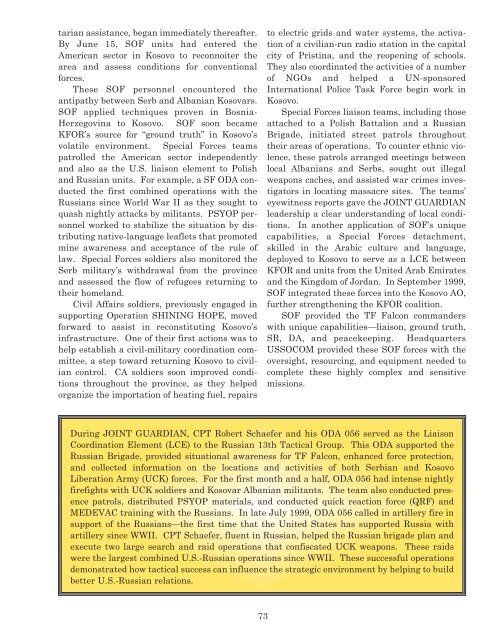HQ$History - United States Special Operations Command
HQ$History - United States Special Operations Command
HQ$History - United States Special Operations Command
You also want an ePaper? Increase the reach of your titles
YUMPU automatically turns print PDFs into web optimized ePapers that Google loves.
tarian assistance, began immediately thereafter.<br />
By June 15, SOF units had entered the<br />
American sector in Kosovo to reconnoiter the<br />
area and assess conditions for conventional<br />
forces.<br />
These SOF personnel encountered the<br />
antipathy between Serb and Albanian Kosovars.<br />
SOF applied techniques proven in Bosnia-<br />
Herzegovina to Kosovo. SOF soon became<br />
KFOR’s source for “ground truth” in Kosovo’s<br />
volatile environment. <strong>Special</strong> Forces teams<br />
patrolled the American sector independently<br />
and also as the U.S. liaison element to Polish<br />
and Russian units. For example, a SF ODA conducted<br />
the first combined operations with the<br />
Russians since World War II as they sought to<br />
quash nightly attacks by militants. PSYOP personnel<br />
worked to stabilize the situation by distributing<br />
native-language leaflets that promoted<br />
mine awareness and acceptance of the rule of<br />
law. <strong>Special</strong> Forces soldiers also monitored the<br />
Serb military’s withdrawal from the province<br />
and assessed the flow of refugees returning to<br />
their homeland.<br />
Civil Affairs soldiers, previously engaged in<br />
supporting Operation SHINING HOPE, moved<br />
forward to assist in reconstituting Kosovo’s<br />
infrastructure. One of their first actions was to<br />
help establish a civil-military coordination committee,<br />
a step toward returning Kosovo to civilian<br />
control. CA soldiers soon improved conditions<br />
throughout the province, as they helped<br />
organize the importation of heating fuel, repairs<br />
to electric grids and water systems, the activation<br />
of a civilian-run radio station in the capital<br />
city of Pristina, and the reopening of schools.<br />
They also coordinated the activities of a number<br />
of NGOs and helped a UN-sponsored<br />
International Police Task Force begin work in<br />
Kosovo.<br />
<strong>Special</strong> Forces liaison teams, including those<br />
attached to a Polish Battalion and a Russian<br />
Brigade, initiated street patrols throughout<br />
their areas of operations. To counter ethnic violence,<br />
these patrols arranged meetings between<br />
local Albanians and Serbs, sought out illegal<br />
weapons caches, and assisted war crimes investigators<br />
in locating massacre sites. The teams’<br />
eyewitness reports gave the JOINT GUARDIAN<br />
leadership a clear understanding of local conditions.<br />
In another application of SOF’s unique<br />
capabilities, a <strong>Special</strong> Forces detachment,<br />
skilled in the Arabic culture and language,<br />
deployed to Kosovo to serve as a LCE between<br />
KFOR and units from the <strong>United</strong> Arab Emirates<br />
and the Kingdom of Jordan. In September 1999,<br />
SOF integrated these forces into the Kosovo AO,<br />
further strengthening the KFOR coalition.<br />
SOF provided the TF Falcon commanders<br />
with unique capabilities—liaison, ground truth,<br />
SR, DA, and peacekeeping. Headquarters<br />
USSOCOM provided these SOF forces with the<br />
oversight, resourcing, and equipment needed to<br />
complete these highly complex and sensitive<br />
missions.<br />
During JOINT GUARDIAN, CPT Robert Schaefer and his ODA 056 served as the Liaison<br />
Coordination Element (LCE) to the Russian 13th Tactical Group. This ODA supported the<br />
Russian Brigade, provided situational awareness for TF Falcon, enhanced force protection,<br />
and collected information on the locations and activities of both Serbian and Kosovo<br />
Liberation Army (UCK) forces. For the first month and a half, ODA 056 had intense nightly<br />
firefights with UCK soldiers and Kosovar Albanian militants. The team also conducted presence<br />
patrols, distributed PSYOP materials, and conducted quick reaction force (QRF) and<br />
MEDEVAC training with the Russians. In late July 1999, ODA 056 called in artillery fire in<br />
support of the Russians—the first time that the <strong>United</strong> <strong>States</strong> has supported Russia with<br />
artillery since WWII. CPT Schaefer, fluent in Russian, helped the Russian brigade plan and<br />
execute two large search and raid operations that confiscated UCK weapons. These raids<br />
were the largest combined U.S.-Russian operations since WWII. These successful operations<br />
demonstrated how tactical success can influence the strategic environment by helping to build<br />
better U.S.-Russian relations.<br />
73

















